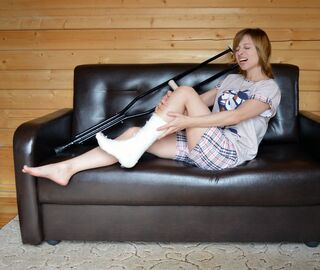Coronavirus Disease 2019
Did the Pandemic Reduce Injuries from High Heels?
New research finds COVID-19 led to fewer high heel-related injuries.
Posted June 7, 2022 Reviewed by Abigail Fagan
Key points
- In two large studies of U.S. women, between 40 and 70 percent of women said they wear shoes that cause pain or blisters.
- Medical research has linked wearing high heels with increased rates of musculoskeletal pain, bunions, and distortions in natural gait.
- During the first year of the COVID-19 pandemic, hospital visits caused by high heel-related injuries substantially decreased.

Women wear painful or uncomfortable clothing substantially more often than men do. Shoes are one of the biggest drivers of this gender difference, in part because of the continued presence of high heels in so many women’s wardrobes. Women frequently report that they wear high heels in order to look sexually appealing to others and seem willing to trade pain for feeling more attractive. But high heels come with a downside that goes beyond blisters: They can contribute to serious injuries, including bone fractures. New research from the University of Maryland found that during the first year of the COVID-19 pandemic, hospital visits caused by high heel-related injuries substantially decreased.
In two large studies of U.S. women, between 40 and 70 percent of women said they wear shoes that cause pain or blisters. While not all uncomfortable shoes are high heels, heels are likely the leading cause of shoe-related pain. The typical motivation for wearing high heels isn’t a mystery. Research has demonstrated that men find women wearing high heels more sexually attractive. For example, in a 2015 study, researchers found that men were more likely to approach a woman when she was wearing heels (either 5 or 9 centimeters high) vs. flats. Men were also more likely to offer help to a woman who was wearing heels vs. flats — agreeing to complete a survey for her or picking up a glove she dropped. But while wearing high heels might make a woman appear sexier to men, heels come with a cost.

One study found that in 2012, over 14,000 women in the U.S. visited an emergency department for a high heel-related injury. Medical research has also linked wearing high heels with increased rates of musculoskeletal pain, bunions, and distortions in one’s natural gait. One study of teachers found that those who wore high heels at work were 1.6 times more likely to get a repetitive strain injury. Among those who seek medical care at a hospital following a fall, wearing heels at the time of the fall is associated with a substantially higher risk of having fractured one’s foot, arm, or pelvis. Older adults who regularly wear high heels are more likely to fall, even if they are not wearing heels at the time of the fall.
For the first year of the COVID-19 pandemic (beginning in mid-March of 2020), U.S. residents experienced substantially reduced geographic mobility, either due to policy restrictions, job loss, or the choice to limit contact with others in order to reduce the risk of infection. Additionally, nearly 25% of the adult population reported regularly working from home. Researchers wondered whether this notable change in mobility combined with fewer opportunities for social contact would lead to fewer high heel-related injuries.
Using data from the Consumer Product Safety Commission’s National Electronic Injury Surveillance System (NEISS), they examined reports of emergency department visits that received the code associated with footwear. For these visits, narrative accounts of the treating physicians were examined for phrases like “high heels,” “platforms,” or “stilettos.” March 15, 2020 was selected as the cut-off date marking the onset of the pandemic in the U.S. The researchers estimated that from 2016 to 2020, there were over 70,000 heel-related injuries treated in emergency departments — about 14,000 per year. For 2020, this number dropped to approximately 6,300. The shoe-injury drop occurred after March 15; for January through March 15 of 2020, the rate of heel-related injury visits looked similar to previous years.

One possibility is that women with less severe high heel-related injuries avoided seeking medical care during the pandemic in order to prevent becoming infected or placing additional burden on stressed hospitals. To account for this possibility, the researchers examined whether the injuries reported after March 15 of 2020 were more severe, on average. Severity was assessed by examining the percent of visits that resulted in a diagnosed fracture or hospital admission. The average severity of heel-related injuries appeared to remain consistent after the pandemic onset; only the frequency of injuries changed.
Perhaps the pandemic can usher in a new era for shoe fashion, one in which women do not feel compelled to wear shoes that increase the risk of injury as a way to appear more attractive. After all, don’t women deserve footwear that prevents injuries instead of prompting visits to the emergency department?


